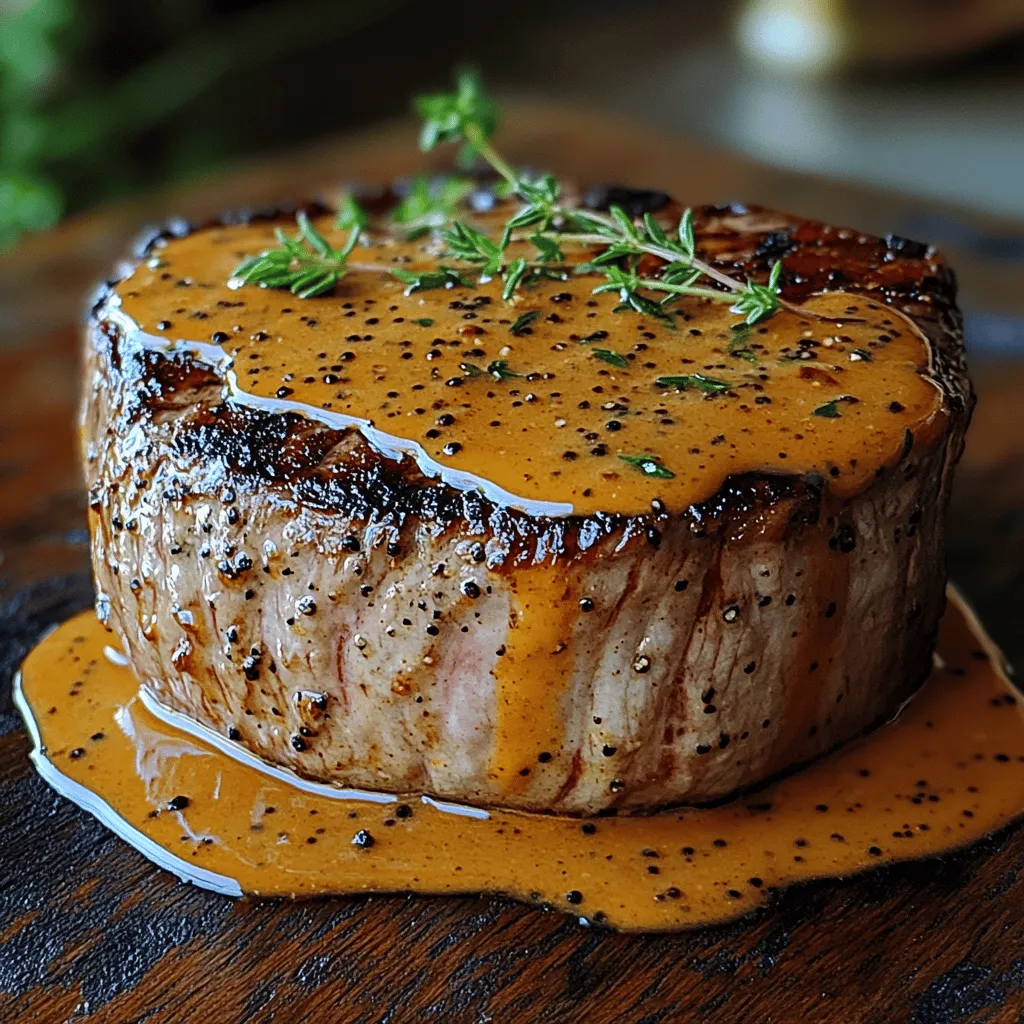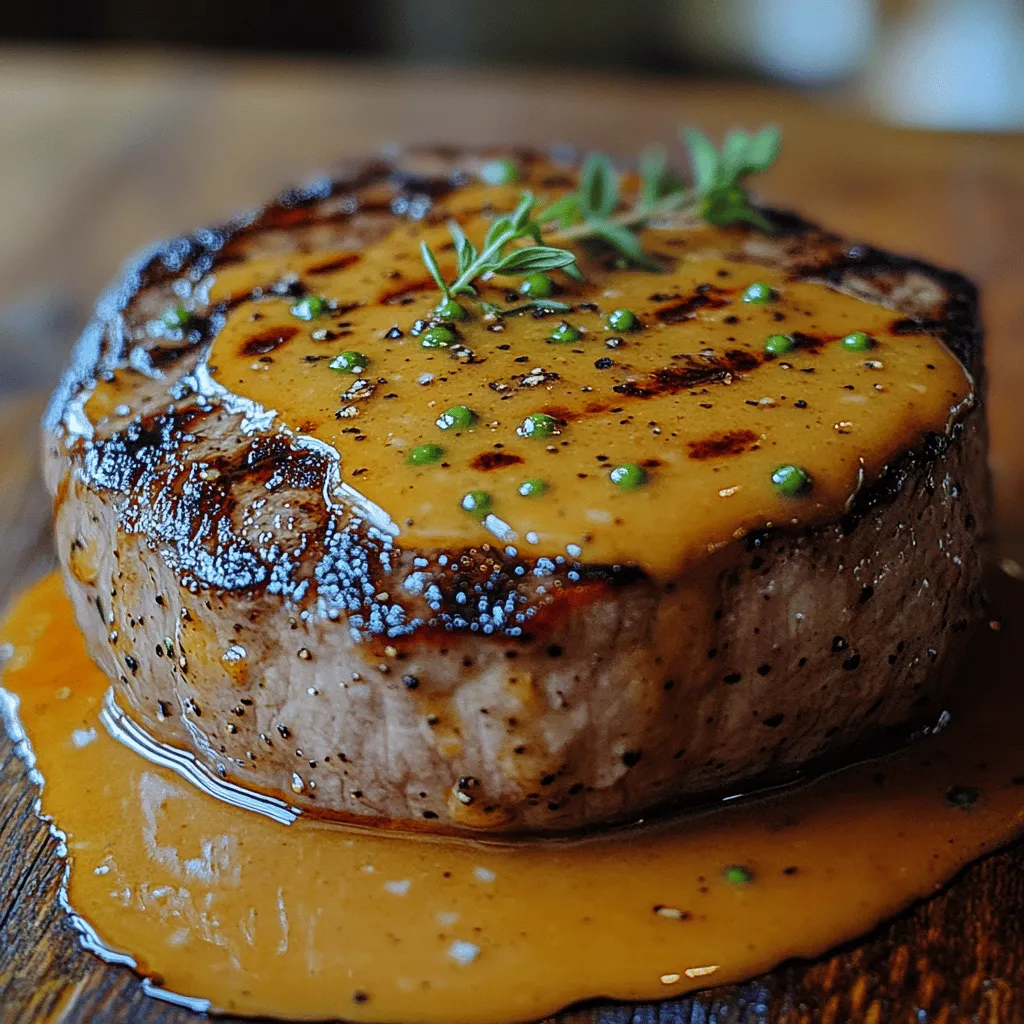Introduction
When it comes to fine dining, few dishes can rival the elegance and flavor of filet mignon. This tender cut of meat is revered not only for its buttery texture but also for its ability to absorb and enhance accompanying flavors. One such remarkable enhancement is the zesty peppercorn sauce, which elevates the steak experience to new heights. The combination of juicy filet mignon and a rich, peppery sauce creates a symphony of flavors that is perfect for special occasions and even for making a weeknight dinner feel luxurious. Whether you’re celebrating a milestone or simply indulging in a culinary treat, this dish promises to impress and satisfy.
Cooking steak to perfection is both an art and a science. The right balance of searing to create a delectable crust while ensuring the interior remains tender and juicy is crucial. The zesty peppercorn sauce plays a pivotal role in this dish, bringing a burst of flavor that complements the natural richness of the filet mignon. In this article, we will explore the nuances of preparing this exquisite meal, offering insights into selecting the finest ingredients and executing the cooking process flawlessly.
Understanding Filet Mignon
Description of Filet Mignon
Filet mignon is a premium cut of beef derived from the tenderloin, a muscle that does very little work, resulting in an exceptionally tender piece of meat. Known for its fine texture and rich flavor, filet mignon is often considered the most luxurious steak option available. The cut is characterized by its small size and rounded shape, making it ideal for individual servings. Its tenderness makes it versatile, allowing it to be served with a variety of sauces and sides, but it is truly at its best when paired with a robust sauce like the zesty peppercorn variety.
Nutritional Benefits of Filet Mignon
In addition to being a culinary delight, filet mignon boasts several nutritional benefits. It is an excellent source of high-quality protein, essential for muscle repair and growth. A typical serving of filet mignon also provides significant amounts of zinc, which supports the immune system, and iron, crucial for maintaining healthy blood cells. While filet mignon is higher in fat compared to leaner cuts, the fat content contributes to its flavor and juiciness.
However, like all foods, moderation is key. Enjoying filet mignon as an occasional treat can fit well into a balanced diet, especially when paired with vegetables or whole grains.
Tips for Selecting the Perfect Filet Mignon
Choosing the right filet mignon is essential for achieving the best flavor and texture in your dish. Here are some tips to help you select the perfect cut:
1. Look for Marbling: Marbling refers to the small streaks of fat within the muscle. A well-marbled filet mignon will have a good balance of fat and meat, resulting in a more flavorful and juicy steak.
2. Check the Color: Fresh filet mignon should have a bright, cherry-red color. Avoid any cuts that appear brown or gray, as this can indicate aging.
3. Thickness Matters: Aim for filet mignon steaks that are at least 1.5 to 2 inches thick. Thicker cuts allow for a perfect sear on the outside while ensuring the inside remains tender and juicy.
4. Ask Your Butcher: If you’re unsure, don’t hesitate to ask your butcher for recommendations. They can provide insights into the best cuts available and may even have special selections for you to consider.
5. Consider Grass-Fed vs. Grain-Fed: Grass-fed beef is often leaner with a slightly different flavor profile compared to grain-fed beef. Depending on your taste preference, you may opt for one over the other.
By keeping these tips in mind, you can ensure that you bring home the best filet mignon for your zesty peppercorn sauce creation.
Essential Ingredients and Their Roles
Creating the perfect filet mignon with zesty peppercorn sauce requires high-quality ingredients that work together to enhance the overall flavor of the dish. Here’s a look at the key components:
Filet Mignon Steaks: Quality and Preparation
As previously mentioned, filet mignon is the star of this dish. The quality of the steak is paramount, so it’s worth investing in a high-grade cut. Before cooking, allow the steaks to come to room temperature, which helps them cook evenly. Pat them dry with paper towels to ensure a good sear, and season generously with salt and freshly cracked black pepper.
Seasoning: The Importance of Salt and Pepper
Simple yet effective, salt and pepper are the cornerstone of flavor in any steak recipe. Salt not only enhances the natural flavor of the beef but also helps to create a savory crust when seared. Freshly cracked black pepper adds a warm, aromatic kick, which is particularly important in this recipe, as it complements the zesty peppercorn sauce.
Olive Oil and Butter: Flavor and Cooking Techniques
Using both olive oil and butter in the cooking process adds layers of flavor to the filet mignon. Olive oil has a high smoke point, making it ideal for searing the steak at high temperatures without burning. Butter, on the other hand, adds richness and a velvety texture. It is typically added towards the end of the cooking process, allowing it to baste the steak and impart a sumptuous finish.
Shallots and Garlic: Aromatics that Enhance the Dish
Shallots and garlic are essential aromatics in the preparation of the peppercorn sauce. Shallots, with their delicate and slightly sweet flavor, provide a wonderful depth to the sauce, while garlic adds a savory note that rounds out the overall taste. When sautéed in the residual fat from the cooked steak, they create a flavorful base that enhances the sauce’s complexity.
Peppercorns: Types and Flavor Profiles
The zesty peppercorn sauce thrives on the use of various peppercorns, each contributing unique flavors. Typically, a combination of black, white, and green peppercorns is used:
– Black Peppercorns: Bold and pungent, black peppercorns provide heat and depth.
– White Peppercorns: Milder than black pepper, white pepper adds a different layer of flavor without overpowering the dish.
– Green Peppercorns: These are less mature than black peppercorns and offer a fresh, slightly fruity taste.
Utilizing a mix of these peppercorns will create a well-rounded sauce with depth and complexity.
Beef Broth and Heavy Cream: Creating a Rich Sauce
To build the body of the peppercorn sauce, beef broth serves as an excellent base, providing a rich, meaty flavor. Heavy cream is then added to create a luscious, velvety texture that coats the steak beautifully. The combination of these two ingredients results in a sauce that is both robust and indulgent.
Dijon Mustard: Adding Depth and Zest
Dijon mustard plays a pivotal role in the zesty peppercorn sauce, lending a sharp, tangy flavor that cuts through the richness of the cream. It adds complexity and brightness to the sauce, elevating the overall taste profile of the dish.
Fresh Thyme: The Finishing Touch for Aroma and Presentation
Fresh thyme is the final ingredient that ties everything together. Its earthy flavor complements the peppercorn sauce beautifully, and using fresh herbs adds a vibrant touch to the dish. Additionally, thyme’s aromatic qualities enhance the overall dining experience, making each bite more enticing.
Preparation Steps for Perfect Filet Mignon
Now that we’ve covered the essential ingredients, let’s delve into the preparation steps that will help you achieve the perfect filet mignon with zesty peppercorn sauce.
1. Prepare the Steaks: Begin by taking the filet mignon steaks out of the refrigerator and letting them rest at room temperature for about 30 minutes. This step is crucial, as it ensures even cooking throughout the steak.
2. Season Generously: Pat the steaks dry with paper towels, then liberally season both sides with kosher salt and freshly cracked black pepper. The seasoning forms a flavorful crust when seared.
3. Heat the Pan: Place a large skillet or cast-iron pan over medium-high heat. Add a tablespoon of olive oil, allowing it to heat until shimmering but not smoking.
4. Sear the Steaks: Carefully add the seasoned filet mignon to the hot pan. Sear for about 4-5 minutes on one side without moving them, allowing a rich crust to form. Flip the steaks and add a couple of tablespoons of butter to the pan.
5. Baste for Flavor: As the second side cooks, tilt the pan slightly and use a spoon to baste the melted butter over the top of the steaks. This technique infuses the meat with flavor and helps achieve a perfect medium-rare doneness.
6. Check for Doneness: Use a meat thermometer to check the internal temperature of the steaks. For medium-rare, aim for an internal temperature of 130°F (54°C). Remove the steaks from the pan and let them rest on a cutting board for at least 5 minutes before slicing. This resting period allows the juices to redistribute, ensuring a tender and juicy steak.
7. Prepare the Sauce: In the same pan, add the shallots and garlic, sautéing them in the residual fat until fragrant and translucent. Deglaze the pan with beef broth, scraping up any browned bits from the bottom. Add the heavy cream, Dijon mustard, and peppercorns, stirring to combine.
8. Simmer and Thicken: Bring the sauce to a gentle simmer and let it cook for a few minutes until it thickens slightly. Finish by stirring in fresh thyme and adjusting the seasoning with salt and pepper to taste.
These preparation steps ensure that your filet mignon is cooked to perfection and accompanied by a rich, flavorful zesty peppercorn sauce. In the next part of this article, we will dive deeper into serving suggestions, pairing ideas, and tips for making this dish a memorable experience. Stay tuned for the continuation of this culinary journey, where we will explore how to elevate your dining experience with filet mignon and zesty peppercorn sauce.

Importance of Bringing Steaks to Room Temperature
To achieve the perfect filet mignon, one of the most critical steps is allowing your steaks to come to room temperature before cooking. This can take about 30 minutes, depending on the thickness of the steaks. Bringing the meat to room temperature ensures even cooking throughout. If you place cold steaks directly onto a hot grill or skillet, the exterior may cook too quickly, leading to an overcooked outside and undercooked inside. By allowing the steaks to warm up, you create a more uniform doneness, resulting in a tender and juicy filet mignon.
Seasoning the Steaks
An essential part of preparing your filet mignon is seasoning. The right seasoning enhances the natural flavors of the beef without overpowering them.
1. Start by patting your steaks dry with paper towels; moisture on the surface can prevent a good sear.
2. Generously sprinkle kosher salt on both sides of the steaks. Salt not only seasons but also helps to draw out moisture, creating a savory crust.
3. Follow with freshly cracked black pepper, which adds a robust flavor. For a zesty kick, consider adding a hint of crushed red pepper or your favorite steak seasoning blend.
4. Allow the seasoned steaks to sit for 10-15 minutes to absorb the flavors and help with the formation of a crust when cooked.
Techniques for Achieving the Ideal Sear and Doneness
Achieving that perfect sear on your filet mignon is all about the technique. You want a beautiful brown crust that forms on the outside while keeping the inside tender and juicy. Here are some steps to follow:
1. Heat Your Pan: Begin by preheating your skillet or grill over medium-high heat. You want the surface to be hot enough that when you place the steak down, it sizzles. If using a cast-iron skillet, it’s particularly effective for searing due to its heat retention properties.
2. Oil the Pan: Add a high-smoke-point oil, such as canola or avocado oil, to the skillet. Swirl it around so that it coats the bottom evenly.
3. Sear the Steak: Place the filet mignon in the pan without overcrowding. You should hear a satisfying sizzle. Let it cook undisturbed for about 3-5 minutes, depending on thickness, until a rich brown crust forms. Avoid flipping too soon, as this can prevent proper searing.
4. Flip and Cook: After achieving a nice sear on the first side, flip the steak and reduce the heat to medium. Continue to cook for another 3-5 minutes, depending on your desired level of doneness.
Explanation of Different Doneness Levels and Their Temperatures
Understanding steak doneness is key to achieving the perfect filet mignon. Each level of doneness corresponds to a specific internal temperature:
– Rare: 120°F (49°C) – Cool, red center.
– Medium Rare: 130°F (54°C) – Warm, red center; this is considered the ideal doneness for filet mignon.
– Medium: 140°F (60°C) – Warm, pink center.
– Medium Well: 150°F (66°C) – Slightly pink center.
– Well Done: 160°F (71°C) and above – Little to no pink.
Using an instant-read meat thermometer is the most reliable way to check doneness. Insert the thermometer into the thickest part of the steak to get an accurate reading.
Resting the Steak: Why It’s Crucial for Texture and Flavor
Resting your steak after cooking is a vital step that should never be overlooked. When meat cooks, the juices are pushed toward the center. If you cut into a steak immediately after cooking, those juices will escape, leaving you with a dry piece of meat.
To rest your filet mignon, remove it from the heat and place it on a cutting board. Tent it loosely with aluminum foil to keep it warm. Allow it to rest for at least 5-10 minutes. This resting period allows the juices to redistribute evenly throughout the steak, enhancing both flavor and texture.
Creating the Zesty Peppercorn Sauce
Now that your filet mignon is cooked to perfection, it’s time to whip up the zesty peppercorn sauce that will elevate your dish. This sauce is creamy, tangy, and has a wonderful kick thanks to the peppercorns.
1. Sautéing Shallots and Garlic: Start by using the same skillet where you cooked the steak. The residual oils and fond will add depth to your sauce. Crank up the heat to medium and add finely chopped shallots and minced garlic. Sauté for about 2-3 minutes, stirring frequently, until they become fragrant and translucent. This step builds the base flavor for your sauce.
2. Deglazing the Skillet: Once the shallots and garlic are sautéed, it’s time to deglaze the skillet. Pour in a splash of beef broth or red wine, scraping up the browned bits from the bottom of the pan with a wooden spoon. These bits are packed with flavor and will enhance your sauce significantly.
3. Reducing Broth: Allow the broth to simmer and reduce for about 5 minutes. This concentration of flavors will create a rich foundation for your sauce.
4. Incorporating Cream and Mustard: After the broth has reduced, lower the heat and stir in heavy cream and a teaspoon of Dijon mustard. The cream adds a velvety texture, while the mustard contributes a tangy richness. Stir continuously until the sauce thickens slightly, about 3-4 minutes.
5. Adjusting Seasoning: Finally, taste your sauce and adjust the seasoning as needed. You may want to add more salt, pepper, or even a squeeze of lemon juice for additional brightness. The goal is a balanced flavor that complements the richness of the filet mignon.
Serving Suggestions
Presentation is key when serving your filet mignon with zesty peppercorn sauce. Here are some ideas to make your dish visually appealing and delicious:
Presentation Ideas:
– Plate the steak in the center of a warm dinner plate. Drizzle the zesty peppercorn sauce generously over the top.
– Garnish with fresh herbs, such as parsley or chives, for a pop of color.
– Serve with a side of creamy mashed potatoes and sautéed vegetables for a complete meal.
Recommended Side Dishes:
To complement your filet mignon, consider these side dishes that pair beautifully with the rich flavors of the sauce:
– Creamy Mashed Potatoes: For a classic pairing, creamy mashed potatoes are a must. To make, boil peeled potatoes until tender, then mash with butter, cream, salt, and pepper to taste. For an extra layer of flavor, consider adding roasted garlic or cream cheese.
– Sautéed Vegetables: Seasonal vegetables like asparagus, green beans, or Brussels sprouts are excellent choices. Sauté them in olive oil or butter with a pinch of salt until tender, ensuring they retain their vibrant color and crunch.
Wine Pairings:
A good wine can elevate your dining experience. For a filet mignon, a full-bodied red wine such as Cabernet Sauvignon or Malbec pairs beautifully. The bold flavors of the wine complement the richness of the beef and the zesty sauce.
Conclusion
The filet mignon with zesty peppercorn sauce is not just a dish; it’s a culinary experience that showcases your cooking skills while providing comfort and indulgence. The tender, juicy beef combined with the creamy, tangy sauce creates a perfect harmony of flavors and textures that will impress anyone at your table.
As you embark on this cooking journey, remember that the process is just as important as the final result. Enjoy the act of cooking, take your time to savor each step, and share the delicious outcome with loved ones. After all, good food is meant to be shared, and there’s nothing quite like a homemade meal that brings people together. So, gather around the table, raise a glass, and dig into your exquisite filet mignon with zesty peppercorn sauce—bon appétit!

